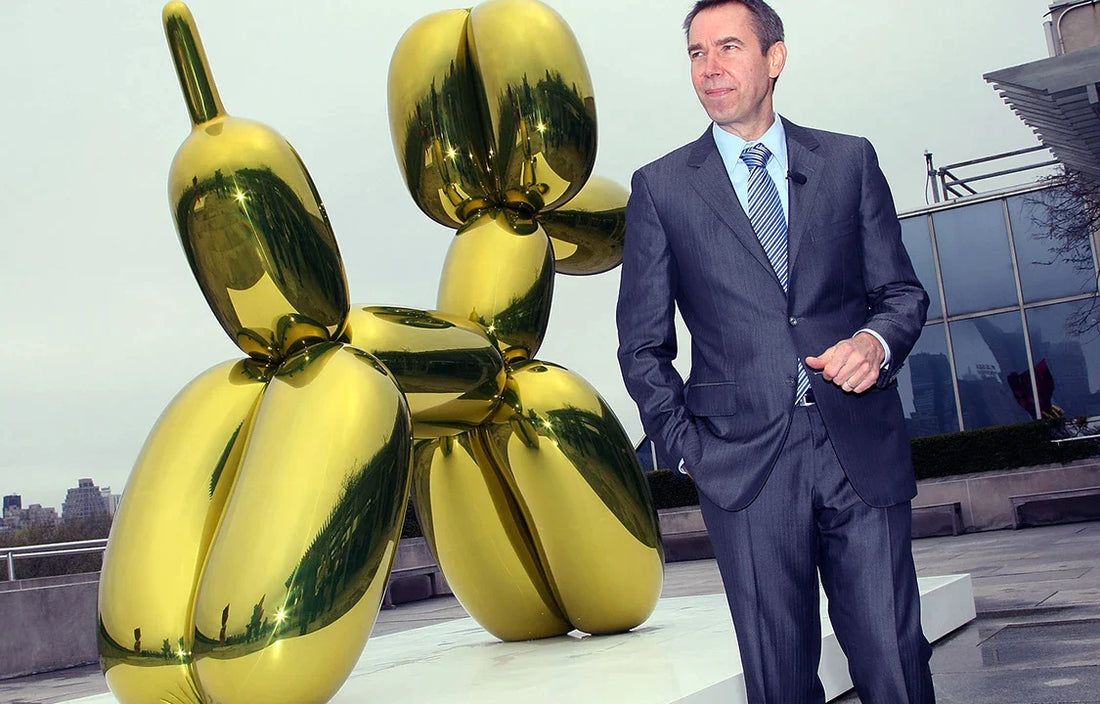What do you think about when you hear the name “Jeff Koons?”
Perhaps the name doesn’t ring a bell at first glance, but if you heard “balloon dog,” you could probably picture one of his many sculptures. Jeff Koons is considered one of the priciest artists in the contemporary art space. His famous porcelain and floral balloon dog sculptures landed him a net worth of $400 million. Vulture even dubbed him “the most successful artist since Warhol.”
Fame is often a double-edged sword, with controversy following suit. In 2008, Koons exhibited 17 works in the Palace of Versailles. Many were hesitant for such art to be in an exhibition within such a sacred location for both art and human history. A common word associated with Koons’s work relative to the work within the palace is kitsch, describing an artwork as overly-imitated, mass-produced pieces with little depth. It is a pejorative term, but that does not mean that a work cannot be enjoyed if it is considered tacky and over-produced. Many associate the high status of his work with the price tag rather than creativity and expression. Andy Warhol also ended up associated with this adjective, again paralleling the two in their approach to modern art and the depth of the works’ minute nuance. Other works that are described as kitschy are the Mona Lisa and Starry Night.

The President of the Republic received a note from UNICEF calling for “an immediate end to the scandal of the Jeff Koons Versailles exhibition, which [was] an offense to the Republic’s legitimate emblems and [harmed] France’s vital interests.”
Koons said his balloon dogs symbolize the human experience —the sculptures hold a nostalgia factor, taking viewers back to their childhood and reminding them of simpler times.
Much like the response to his art, his position as an employer also has mixed reviews. His work has so many hands involved to intentionally create the effect that the result was not achieved by a human. With so many cooks in the kitchen working on multiple projects, employee unrest was almost inevitable. These employees focus on the crafting and producing of Koons’s sculptures in sets of series. Thousands of balloon dog sculptures exist today.
Yes, thousands.
In 2016, Art F City reported a mass layoff of employees at Koon’s studio in Chelsea. Reports say that 14 ex-employees were reported beginning the process of unionization. Around the same time, the studio received a raise amidst a lull in large projects. Employees brought on board after June 1, 2015, were unceremoniously laid off.
“I really enjoyed the job, the work, and the co-workers. But there is no job security. They would hire dozens of people at once. Then sometime later people would show up to work as usual and they'd lay off about half the employees,” a former employee on Indeed wrote. Jeff Koons LLC currently has a 3-star rating on the platform.

That same year, Koons gifted his sculpture Bouquet of Tulips to the city of Paris after the terrorist attacks in 2015 and 2016, leaving 137 dead and at least 400 wounded. Koons told The Guardian the tulips represented the progress of time, and as humanity moves along, we grow stronger. Amidst the chaos from the events that took place, concerns arose around Koons’s gift, worried he was using the terror attacks as a publicity stunt. However, much of the discourse revolved around the art itself, and an emotionally charged debate on art.
In 2022, Jeff Koons announced his first NFT project to go into space, making breakthroughs in the intersection of art and space. Moon Phases features images of these lunar patterns and come with a sculpture to be placed on the moon and a sculpture to remain on Earth. The NFT of the single moon phase comes with Koons’s signature. Pace Gallery sold these NFTs at Art Basel Switzerland for $2 million each. As of late, the press has stopped talking about his endeavors in digital space art.
By now, you’ve caught wind of the balloon dog sculpture that broke at a VIP-exclusive event for the opening night of Art Wynwood in Miami, Florida. The sculpture was left unsecured and unprotected on a sole podium. Amidst the hustle and bustle of the event, a woman knocked against the stand, and the balloon dog clumsily fell to the ground. This particular balloon dog was worth $42,000 and was part of a 799-piece collection titled Balloon Dog (Blue). Now there are only 798 balloon dogs in existence from this batch of porcelain puppies.

This blunder gained so much media traction because it was a Jeff Koons work that shattered. The loss certainly put his name back into the mainstream limelight. However, artist and collector discourse highlights that while multiple news outlets continue to report the balloon dog blunder as a loss to the modern art world, artists are not grieving, referring to the sheer size of the batch of balloon dogs that came with this collection.
Some collectors found elevated value in the shards of the balloon dog. NPR reported on collector and artist Steven Gameson looking into purchasing the shards of the sculpture that tumbled to its death. He watched the balloon dog fall just as he discussed it with his peers. He tried to purchase the fragments on the spot for its new history.
"I find value in it even when it's broken," Gamson told the Miami Herald. "To me, it's the story. It makes the art even more interesting."
These infamous balloon dogs serve as an ode to the overproduction and oversaturation of contemporary art. More recently, collectors found more value in the destruction of these pieces than in their mass-produced form.
©ArtRKL™️ LLC 2021-2023. All rights reserved. This material may not be published, broadcast, rewritten or redistributed. ArtRKL™️ and its underscore design indicate trademarks of ArtRKL™️ LLC and its subsidiaries.





